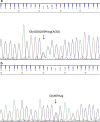Autosomal dominant distal renal tubular acidosis caused by a mutation in the anion exchanger 1 gene in a Japanese family
- PMID: 28509104
- PMCID: PMC5413770
- DOI: 10.1007/s13730-015-0172-3
Autosomal dominant distal renal tubular acidosis caused by a mutation in the anion exchanger 1 gene in a Japanese family
Abstract
Autosomal dominant distal renal tubular acidosis (dRTA) is a rare disorder caused by a mutation in the AE1 gene encoding the chloride-bicarbonate (Cl-/HCO3-) anion exchanger 1 (AE1). Most patients with this disorder present with clinical symptoms in adulthood and their phenotype is milder than that of those with autosomal recessive dRTA. In this report, we describe a Japanese family with autosomal dominant dRTA in which the mother and her daughter presented with severe symptoms caused by hypokalemia at 2 years of age. The heterozygous AE1 mutation G609R, which is a known causative mutation of dRTA, was identified in both patients. To our knowledge, this is the first report of a Japanese family with autosomal dominant type dRTA caused by an AE1 mutation. We, therefore, propose that alterations of AE1 should be considered causative of autosomal dominant dRTA even if typical symptoms appear during early childhood and the clinical features are severe.
Keywords: Anion exchanger 1; Autosomal dominant; Distal renal tubular acidosis; Dominant negative; Hypokalemia; SLC4A1.
Figures
Similar articles
-
Autosomal recessive distal renal tubular acidosis caused by G701D mutation of anion exchanger 1 gene.Am J Kidney Dis. 2002 Jul;40(1):21-9. doi: 10.1053/ajkd.2002.33909. Am J Kidney Dis. 2002. PMID: 12087557
-
Mutations in the chloride-bicarbonate exchanger gene AE1 cause autosomal dominant but not autosomal recessive distal renal tubular acidosis.Proc Natl Acad Sci U S A. 1998 May 26;95(11):6337-42. doi: 10.1073/pnas.95.11.6337. Proc Natl Acad Sci U S A. 1998. PMID: 9600966 Free PMC article.
-
A different clinical manifestation in a Japanese family with autosomal dominant distal renal tubular acidosis caused by SLC4A1 mutation.CEN Case Rep. 2020 Nov;9(4):442-445. doi: 10.1007/s13730-020-00500-x. Epub 2020 Jul 6. CEN Case Rep. 2020. PMID: 32632909 Free PMC article.
-
Hereditary distal renal tubular acidosis: new understandings.Annu Rev Med. 2001;52:471-84. doi: 10.1146/annurev.med.52.1.471. Annu Rev Med. 2001. PMID: 11160790 Review.
-
The association between familial distal renal tubular acidosis and mutations in the red cell anion exchanger (band 3, AE1) gene.Biochem Cell Biol. 1998;76(5):723-8. doi: 10.1139/bcb-76-5-723. Biochem Cell Biol. 1998. PMID: 10353704 Review.
Cited by
-
Distal renal tubular acidosis: genetic causes and management.World J Pediatr. 2019 Oct;15(5):422-431. doi: 10.1007/s12519-019-00260-4. Epub 2019 May 11. World J Pediatr. 2019. PMID: 31079338 Review.
-
Combination of furosemide and fludrocortisone as a loading test for diagnosis of distal renal tubular acidosis in a pediatric case.CEN Case Rep. 2020 Feb;9(1):81-86. doi: 10.1007/s13730-019-00432-1. Epub 2019 Nov 8. CEN Case Rep. 2020. PMID: 31705302 Free PMC article.
-
Personalized Intervention in Monogenic Stone Formers.J Urol. 2018 Mar;199(3):623-632. doi: 10.1016/j.juro.2017.09.143. Epub 2017 Oct 20. J Urol. 2018. PMID: 29061541 Free PMC article. Review.
-
Renal Tubular Acidosis: H+/Base and Ammonia Transport Abnormalities and Clinical Syndromes.Adv Chronic Kidney Dis. 2018 Jul;25(4):334-350. doi: 10.1053/j.ackd.2018.05.005. Adv Chronic Kidney Dis. 2018. PMID: 30139460 Free PMC article. Review.
-
Physiotherapy Strategies in Hypokalemic Periodic Paralysis: A Case Report.Cureus. 2024 Jan 15;16(1):e52294. doi: 10.7759/cureus.52294. eCollection 2024 Jan. Cureus. 2024. PMID: 38357046 Free PMC article.
References
-
- Alper SL. Familial renal tubular acidosis. J Nephrol. 2010;23(Suppl 16):S57–S76. - PubMed
LinkOut - more resources
Full Text Sources
Other Literature Sources
Miscellaneous


